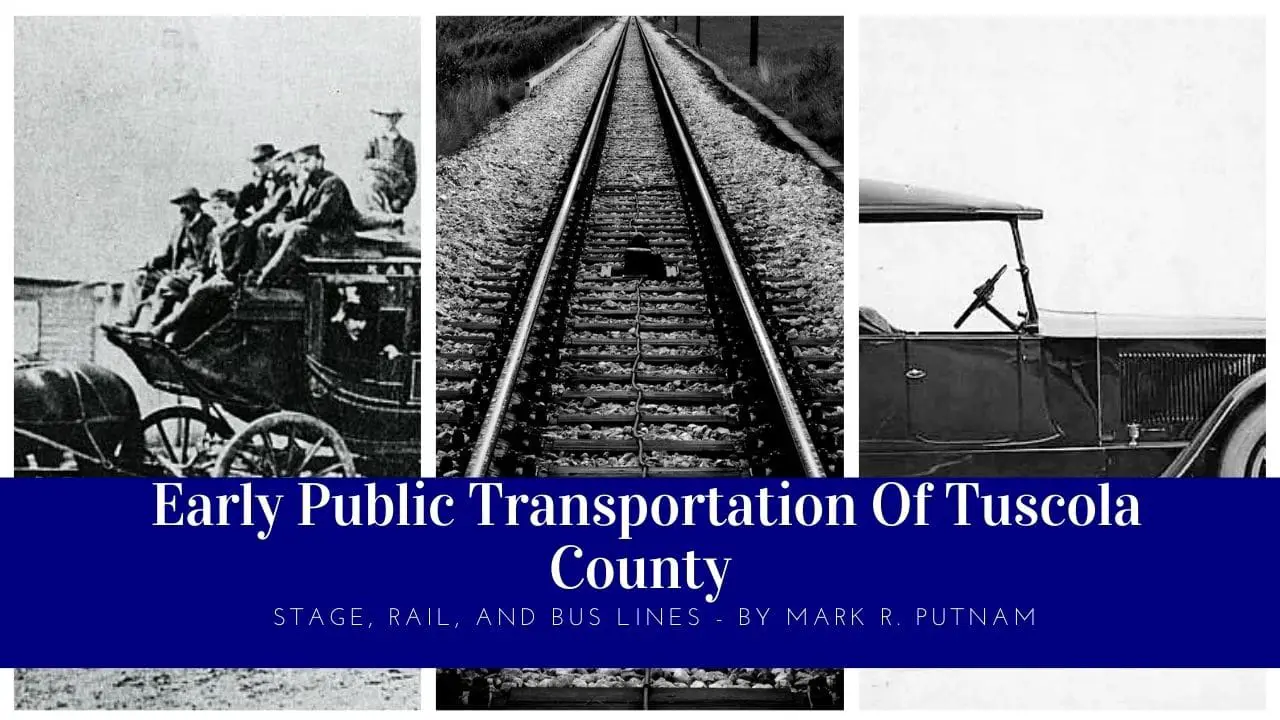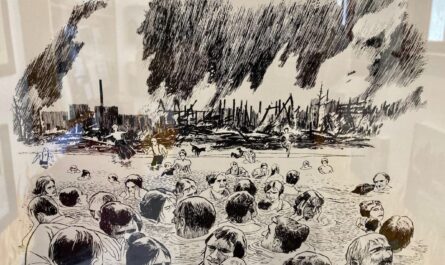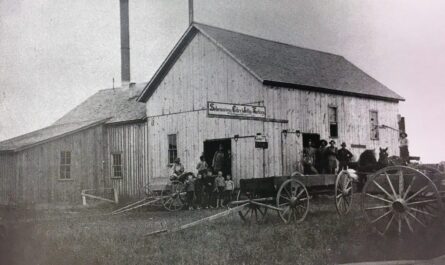In early Tuscola County, the Indian trails along the higher ridges and the Cass River were major means of transportation or travel, whether by foot, pony, or canoe. Tuscola County public transportation services, have evolved from oxcart, stagecoach, rail, and bus. We look back at its evolution in Michigan’s Thumb region.
The earliest traveler was the native person, then came the fur trader, and later the pioneer or settler. Today, M-81 and M-24 in Tuscola County run along these high ridges and essentially follow what was once the two key Indian trails that intersected at what is today the City of Caro, Michigan. These Indian trails and early roads laid the groundwork for establishing a public transportation system for over 100 years in Michigan’s Thumb.
Early Roads in Tuscola
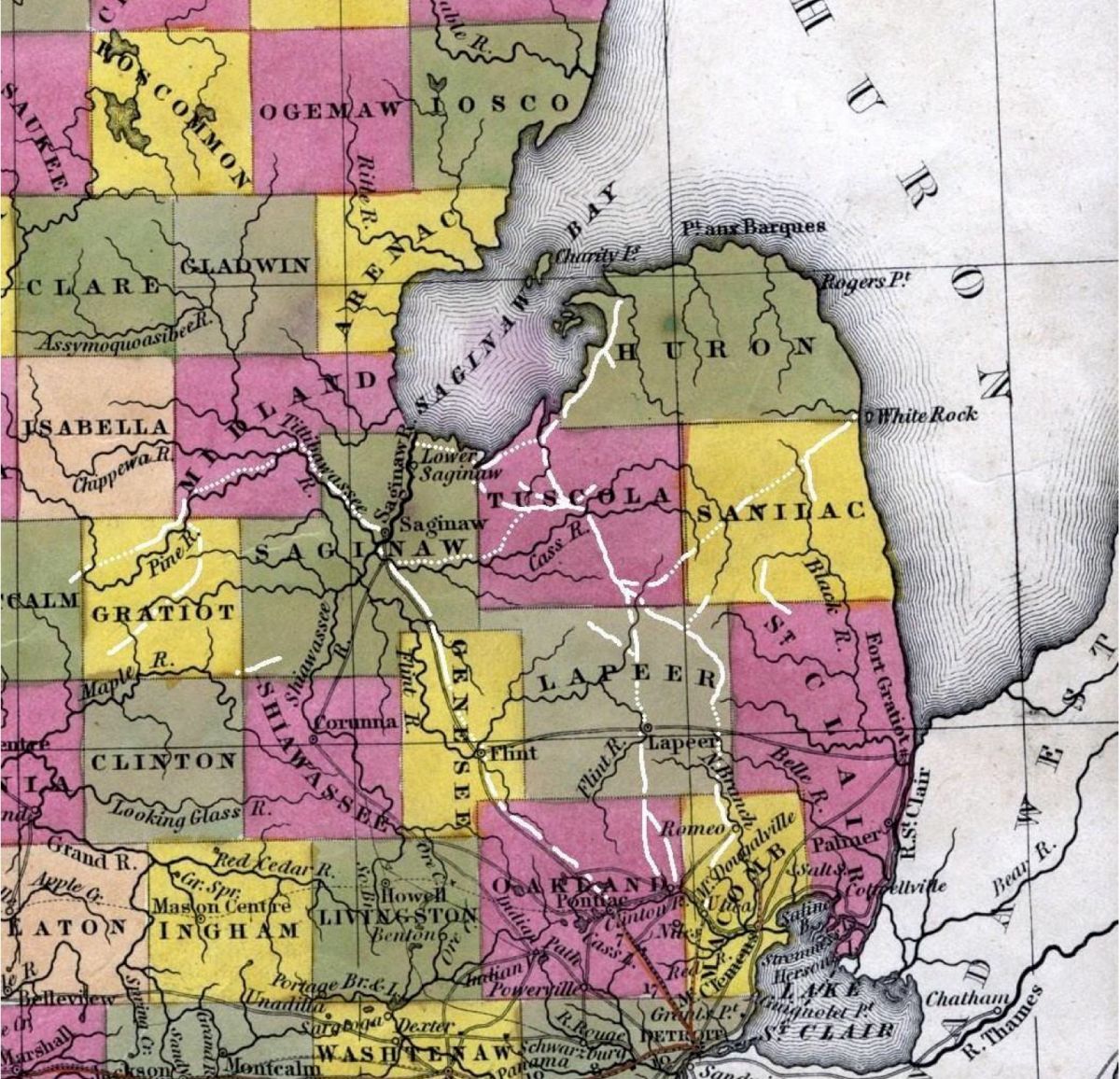
In the 1850s, lumbermen and settlers alike began building rough sectional, logging, and other roads to get around, to conduct business, and to enjoy life in the burgeoning Tuscola County. With the development of the State Road that ran east and west through the center of Tuscola County and other roads, in the late 1850s and 1860s, wagons came into common use. One of the first forms of public transportation was hitching a ride on the back of someone’s ox-drawn wagon.
The Stage Coach Era
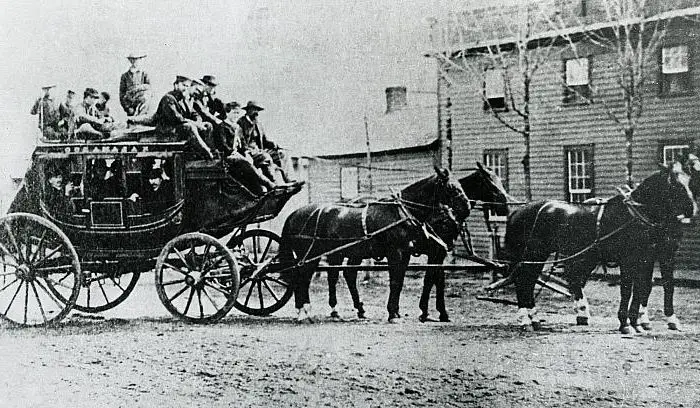
During the 1860s and early 1870s, stagecoach lines grew to become the major and most popular means of public transportation. In 1863, the Pine Run Stage scampered from Pine Run to Vassar. The Town of Pine Run was on the Saginaw Road, which followed the old Saginaw Indian Trail. The Saginaw Road went between Detroit and Flint. From Flint, it went on to Saginaw, Mi. In 1867, Joseph Garland, a resident of Pine Run, which was located a bit northwest of Flint, owned what was called the Tuscola and Vassar Stage Line.
In the middle of Tuscola County, a stage also came out of Centreville, now called the City of Caro. Centreville was so named because the village was at the center of Tuscola County. This stage line was dubbed the Centerville & Vassar Stage Line, and its route was owned by Centreville resident Alexander P. Cooper who was the son-in-law of Samuel P. Sherman—Caro’s first permanent setter and founder.
Competition Between Stagecoach Lines
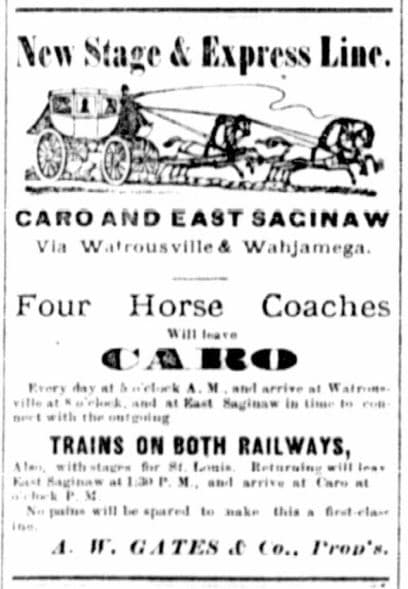
Before the mid-1880s, a vigorous competition took place over the control of the stage lines. In 1870, the Caro & East Saginaw Stage with four horses and coach traveled from Caro and journeyed forty miles to East Saginaw. The stage was known for its speed and departed Caro each day at 6 AM, arrived at Watrousville at 8 AM, and then trotted on to East Saginaw. Gates & Curtis were its proprietors.
The Popular Stage likewise ran between Caro and Saginaw. It routinely left Caro each day early in the morning—except Sunday—at 3:00 AM. It went to Vassar by 7:00 AM and ended the first leg of its turnaround journey in Saginaw by 10:00 AM. After a mid-day sojourn in the City of Saginaw, the Popular Stage left the Saginaw Station at 2:00 PM, arrived in Vassar at 6:00 PM, and then ended the trip in Caro at 10 PM. Passengers touted that they left Caro, visit Saginaw, transact business, and return home to Caro all in the same day, which was quite a marvel!
The Cost of Stagecoach Transportation
By 1878, the Michael Curry Stage was also in the marketplace: It left the Everett House in East Saginaw and headed for the town of Gates, now Reese, at a rate of $1. Going on to the east, it arrived in Watrousville at $1.50; Wahjamega $1.75; Caro $2; and Sebewaing $3.
Another stage, the Saginaw & Vassar Stage, also owned by Michael Curry, left East Saginaw each day and went southeast to the Village of Tuscola for 75 cents and later arrived in Vassar at the total rate of $1. By today’s standards, things were very economical back then, but money was worth much more. In Vassar, the stage stopped at the Jewell House, which Horace Montague and stage owner Michael Curry kept.
This time was the peak of the stage line expansion. At this time, a third stage line went along the sandy, oak ridge, shoreline of east Saginaw Bay. Given the name the Unionville, Sebewaing, and Bay City Mail & Stage, it was owned by George Linder.
The Railroad Era Begins Michigan’s Thumb
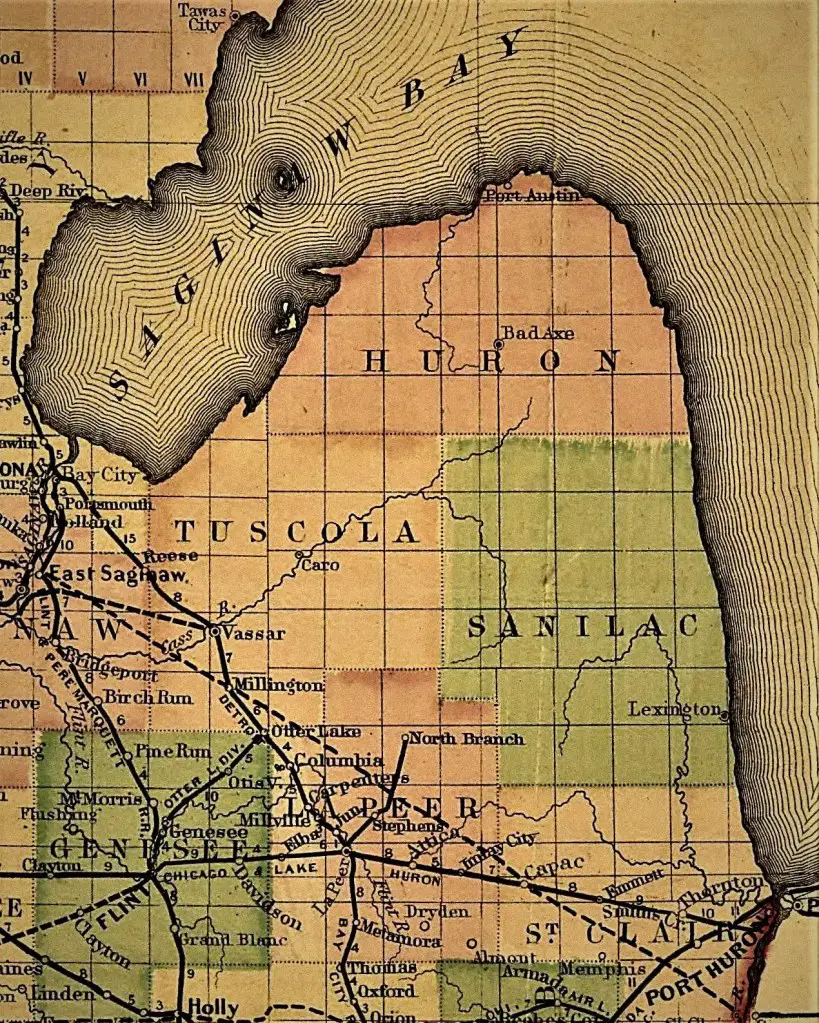
However, a new, more powerful, and more economical competitor soon entered the steam train scene! In 1862, the Flint & Pere Marquette Railroad opened tracks from Saginaw to Mount Morris, MI. Shortly afterward, the company extended its tracts southeast to Flint with a Detroit connection. The rail line later expanded with a branch depot in Vassar.
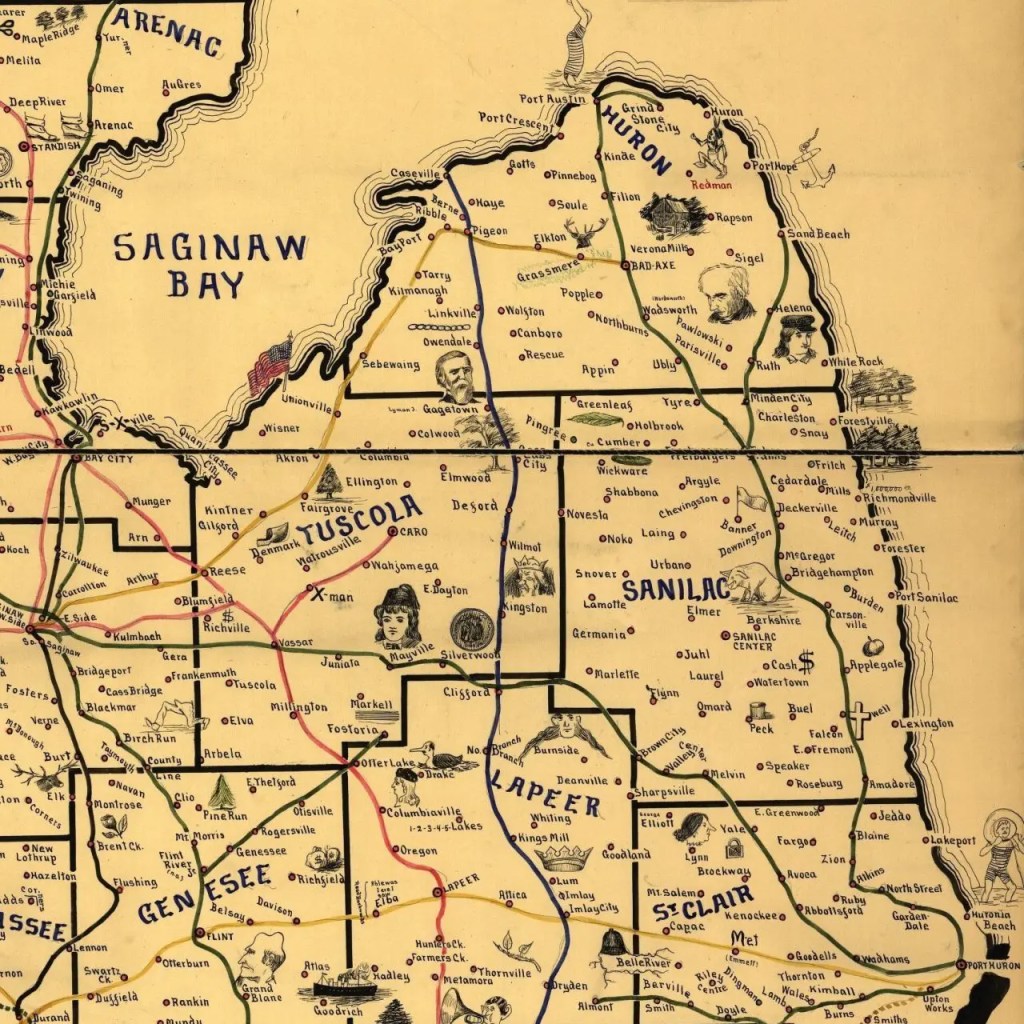
In 1873, the Detroit & Bay City Railroad laid tracks between Otter Lake and Vassar. Its rails later went on to Bay City. In 1874, the East Saginaw and St. Clair Railroad built tacks between Saginaw and Vassar. This line eventually went into Lapeer County. Along the high ridge in northern Lapeer County, the rail line went on to Port Huron in St. Clair County, Mi. Vassar was currently the local hub of transportation for stage and train in Tuscola County.
Competition and Cooperation of Stage and Rail
![Michigan Central [Caro, MI] and Flint & Pere Marquette [Vassar] Rail Schedule - Public Transportation](https://thumbwind.com/wp-content/uploads/2020/11/michigan-central-railroad-schedule-7-23-1897.jpg)
& Pere Marquette [Vassar] Rail Schedules
There was intense competition in some areas and warm cooperation in other areas between the stage and rail lines. Typically, the railroads went to major cities and towns, while stage lines connected the rail depots with smaller towns and villages.
In 1878, an event took place that was colossal! The Michigan Central Railroad laid tracks between Vassar and Caro. The affair was monumental. By 1884, a train would leave Caro at 8 AM, arrived in Wahjamega in 10 minutes, get to the Watrousville Station in 20 minutes, and stop in Vassar in 35 minutes. The Michigan Central provided three roundtrips daily between Caro, the county seat, and Vassar.
When the Michigan Central tracks opened between Vassar and Caro in 1878, Caro’s Alexander P. Cooper saw the writing on the wall. He retired from the stagecoach business. However, his employee David Hemerick stayed in the livery and stagecoach business and partnered with Solomon Utter. The firm then owned the stage line that ran between Caro and Vassar. The Utter & Hemerick Office was in Caro at the Exchange Hotel. It was across the street and west of today’s Tuscola County Courthouse. Their livery or barn was located at the rear of the Exchange Hotel.
In 1883, because of the Michigan Central Railroad competition, Hemerick & Utter discontinued the stage route between Caro and Vassar; however, they kept the route that ran between Caro and Cass City. The railroad stopped in Caro but did not go on to Cass City. The stagecoach lines fought a losing battle with railroad transportation. Rail transport was quicker, smoother, and cheaper.
Plank Roads And the Beginnings of Motor Travel
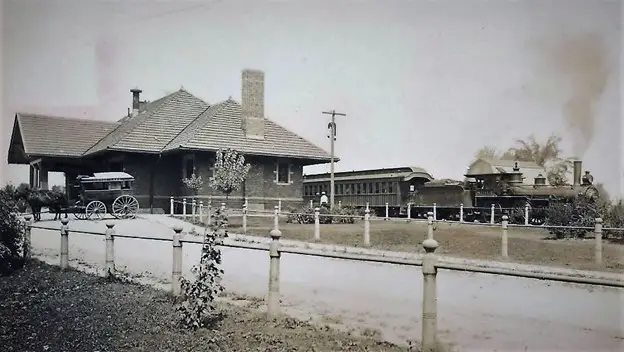
Stage lines went over ground that often was composed of plank roads making stage travel exceedingly bumpy. The roadbed also alternated between being dusty and muddy. By 1904, there were only a few stage lines in Tuscola County, and they went to places where there were no railroad connections. The speed and comfort of the train eventually ended the stagecoach business. Railroads were quicker, and their rates were less pricy.
In 1904, S. Montague owned the 10 Cent Barn and livery in Caro and the ”bus line” that got passengers and baggage to and from the rail station. That year, Montague sold the bus line to H. Walter Cooper, who conducted it in connection with his drayage company. At this time, Caro also was served by the Detroit, Bay City & Western railroad.
Soon, the rail system would meet with a competitor that was even more efficient and convenient than rail travel was for public transportation. This new innovation largely displaced the role of the steam engine and railroad. That innovation was the gasoline engine whose ensuing inventions were the automobile and motorbus.
The Change of Public Transport with the Motor Car
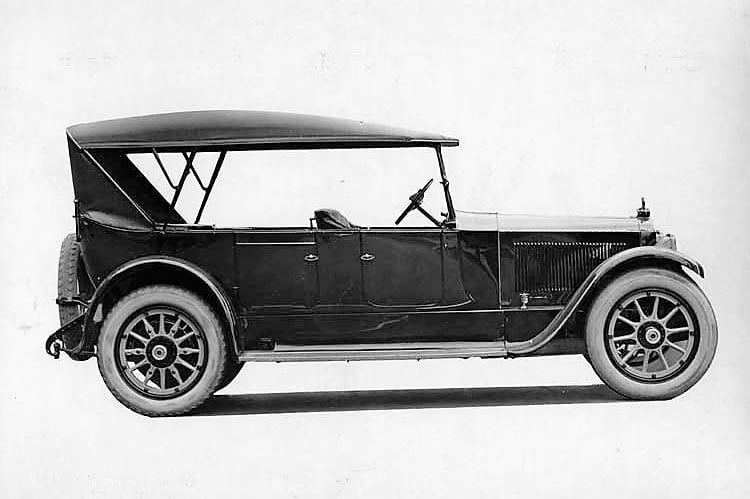
Motor vehicles changed transportation in Tuscola County as they did elsewhere. The touring car and the motor bus were in the early 20th century the most remarkable and workable means of public transportation.
Beginning in 1920, in Tuscola County, high-grade touring cars were used by the public for getting from one place to another. A touring car line that year went from Caro to Flint. It made four trips back and forth daily with stops in Mayville, Vassar, Millington, and Otisville before it reached Flint. It was a real boom to traveling salespeople who would work the towns and “get away without the usual delay” of waiting for a steam train. Herman Randall, formerly of Caro, was a senior member of the company.
At the same time, Edsel Bloomfield started a “motor bus line” that cruised from Caro to Saginaw with stops in Fairgrove, Gilford, and Reese and with a terminal in Saginaw.
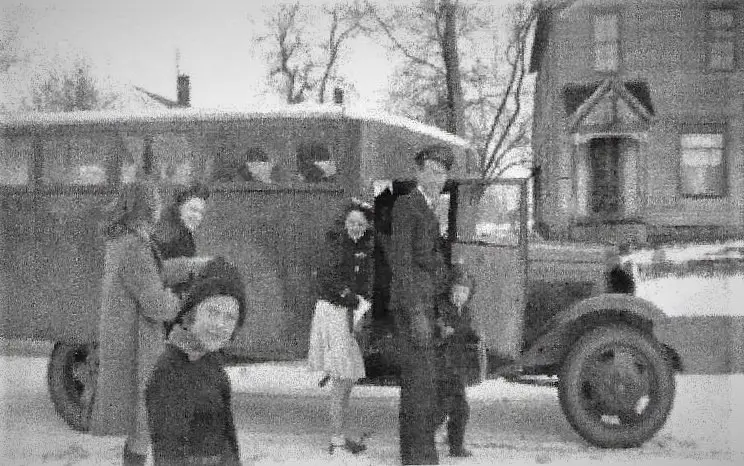
In 1922, Orin Walter owned the Caro & Saginaw Bus line that went from Caro to Watrousville and then went on to Reese and Saginaw. Later that year, the bus line was owned by Ray Rogers. Under his management, the route started in Cass City, ended in Saginaw, and then went back again, daily.
The Elliott Motor Bus Line transported passengers from Cass City to Bad Axe and back. A branch of this bus line also went south to Imlay City and then went further to Pontiac.
Road Improvements Foster Growth in Tuscola
Roads were continuously improved and upgraded, and so were the efficiency and convenience of motor bus travel. In 1925, the Thumb Bus Line opened a new route between Caro and Bay City via Fairgrove and Munger. The company also operated a line from Bad Axe to Saginaw. The company’s two bus lines intersected in Fairgrove.
By the 1930s and early 1940s, three bus lines served Tuscola County: The Young Bus Line; the Hill Bus Line; and the Flint, Caro, & Sebewaing Bus Company. The Young Bus Line was started in 1922 and transported people along M-81 and M-53. It traveled between Caro, the county seat of Tuscola County, and Bad Axe, the county seat of Huron County. The Hill Bus Line was established in 1938 and went from Saginaw to Caro and then went on to Cass City with its destination, also being Bad Axe.
The Flint, Caro, & Sebewaing Bus Company likewise began in the 1930s and transported passengers—north and south—on what today is M-24 through the center of Tuscola County. It also went into Genesee County with a stop at the terminal in Flint.
Post War Public Transportation
In 1945, after World War II, the Indian Trails Bus Company based in Owosso and Flint expanded its route into Michigan’s Thumb. Each Indian Trail coach was named after an American Indian Chief, which made advertising for the company appealing and aspiring. In August 1945, the three bus lines that served the Thumb and Tuscola County consolidated into the Indian Trails Bus Company. George Hill, once the owner of the Hill Bus Line, became the Indian Trails sales manager in the Thumb.
Tuscola County Public Transportation Today
Nonetheless, despite the best efforts, just within a couple of decades or a bit more, the sight of Indian Trails coaches in Tuscola County and the Thumb faded away in the late 20th century. Established in 1998, today, the only mass transit system in central Tuscola County is locally provided by the Thumbody Express that transports people within the City of Caro and Almer and Indianfields Townships with limited service to Cass City, Mayville, and Vassar.
Other Works and Ebooks by Mark R. Putnam
This book is a story about the early automobile interests of Caro, Michigan, the dealerships and garages, and the gas and service stations that have made Caro what it is today.

